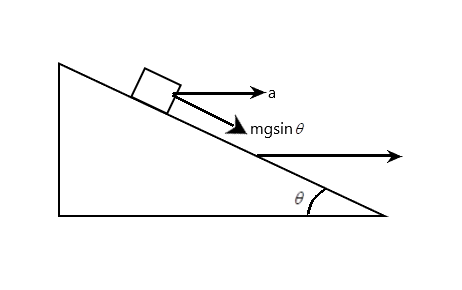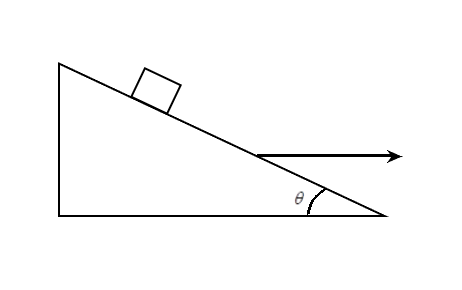
Answer
411.9k+ views
Hint: For the block to appear constant relative to the block, the force pulling the block must create an acceleration which would balance the acceleration due to the weight component of the body. The horizontal force on the block can be modelled according to Newton’s second law.
Formula used: In this solution we will be using the following formulae;
\[W = mg\] where \[W\] is the weight of a body, \[m\] is the mass, and \[g\] is acceleration due to gravity.
\[F = ma\] where \[F\] is the force acting on a body, and \[a\] is the net acceleration of the body.
Complete Step-by-Step solution:

For the block to appear constant relative to the block, the force pulling the block must create an acceleration which would balance the acceleration due to the weight component of the body.
Now, the weight component of the body is simply
\[{W_p} = W\sin \theta = mg\sin \theta \] since (\[W = mg\] where \[W\] is the weight of a body, \[m\] is the mass, and \[g\] is acceleration due to gravity).
Now, the acceleration of the entire wedge is shown to be horizontal. The force acting on the block due to this force causing the acceleration would be given from newton’s law (which is\[F = ma\] where \[F\] is the force acting on a body, and \[a\] is the net acceleration of the body) as
\[{F_b} = ma\]
Now, the component of the force in the same direction as the weight component is
\[{F_p} = ma\cos \theta \]
Since, they must be equal, we have
\[mg\sin \theta = ma\cos \theta \]
Hence,
\[a = g\dfrac{{\sin \theta }}{{\cos \theta }} = g\tan \theta \]
The correct option is D
Note: For clarity, the acceleration points in the same direction as the weight component because, if the wedge is moved forward, due to inertia, the block is though it’ll move backward. This backward fictitious force is equal to the real forward force acting on the wedge.
Formula used: In this solution we will be using the following formulae;
\[W = mg\] where \[W\] is the weight of a body, \[m\] is the mass, and \[g\] is acceleration due to gravity.
\[F = ma\] where \[F\] is the force acting on a body, and \[a\] is the net acceleration of the body.
Complete Step-by-Step solution:

For the block to appear constant relative to the block, the force pulling the block must create an acceleration which would balance the acceleration due to the weight component of the body.
Now, the weight component of the body is simply
\[{W_p} = W\sin \theta = mg\sin \theta \] since (\[W = mg\] where \[W\] is the weight of a body, \[m\] is the mass, and \[g\] is acceleration due to gravity).
Now, the acceleration of the entire wedge is shown to be horizontal. The force acting on the block due to this force causing the acceleration would be given from newton’s law (which is\[F = ma\] where \[F\] is the force acting on a body, and \[a\] is the net acceleration of the body) as
\[{F_b} = ma\]
Now, the component of the force in the same direction as the weight component is
\[{F_p} = ma\cos \theta \]
Since, they must be equal, we have
\[mg\sin \theta = ma\cos \theta \]
Hence,
\[a = g\dfrac{{\sin \theta }}{{\cos \theta }} = g\tan \theta \]
The correct option is D
Note: For clarity, the acceleration points in the same direction as the weight component because, if the wedge is moved forward, due to inertia, the block is though it’ll move backward. This backward fictitious force is equal to the real forward force acting on the wedge.
Recently Updated Pages
How many sigma and pi bonds are present in HCequiv class 11 chemistry CBSE

Mark and label the given geoinformation on the outline class 11 social science CBSE

When people say No pun intended what does that mea class 8 english CBSE

Name the states which share their boundary with Indias class 9 social science CBSE

Give an account of the Northern Plains of India class 9 social science CBSE

Change the following sentences into negative and interrogative class 10 english CBSE

Trending doubts
Fill the blanks with the suitable prepositions 1 The class 9 english CBSE

Which are the Top 10 Largest Countries of the World?

Give 10 examples for herbs , shrubs , climbers , creepers

Difference Between Plant Cell and Animal Cell

Difference between Prokaryotic cell and Eukaryotic class 11 biology CBSE

The Equation xxx + 2 is Satisfied when x is Equal to Class 10 Maths

Change the following sentences into negative and interrogative class 10 english CBSE

How do you graph the function fx 4x class 9 maths CBSE

Write a letter to the principal requesting him to grant class 10 english CBSE




